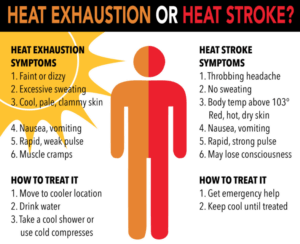
It’s summertime and everyone wants to go out and make the best of the good weather, but it may be to hot to handle. With 2021 being in a record-breaking heat wave, it is safe to say we need to wear sun screen. But so many people don’t realize that being in the sun for prolonged periods of time doesn’t just cause sunburns; but also heat strokes and heat exhaustion. Knowing the difference between a heat stroke and heat exhaustion could be life-saving. While both occur under similar circumstances, the symptoms and severity are vastly different.
Heat Exhaustion:
Heat exhaustion in its most simple terms is your body overheating. This means anytime it is over 98 degrees outside everyone is at risk for heat exhaustion. Symptoms include; excessive sweating, headaches, muscle cramps, vomiting, dehydration, and fainting. The best treatment is to move the affected person to an airconditioned room and encourage them to rehydrate slowly. It may be helpful to take a cold shower or get some cold compressions. In extreme conditions it may be necessary to head to the emergency room to get the fluids in via IV. Though it can be frightening heat exhaustion is usually curable within 24 hours and rarely leads to more serious conditions.

Heat Stroke:
Heat strokes are the silent killers of summertime, heat strokes require immediate medical attention. It’s very common for heat strokes to be mistaken as heat exhaustion due to the similarity in symptoms and causes, but this mistake can be fatal. The most obvious difference is when someone is suffering from heat exhaustion they will sweat excessively, while if someone is having a heat stroke they can no longer sweat at all. Another tell-tell sign the person is suffering a heat stroke is confusion, if they can’t tell you what day it is or what month it is there is a good chance they are having a heat stroke.

Here are a couple of links with further information:
Know the Difference Between Heat Stroke and Heat Exhaustion | Beaumont Health